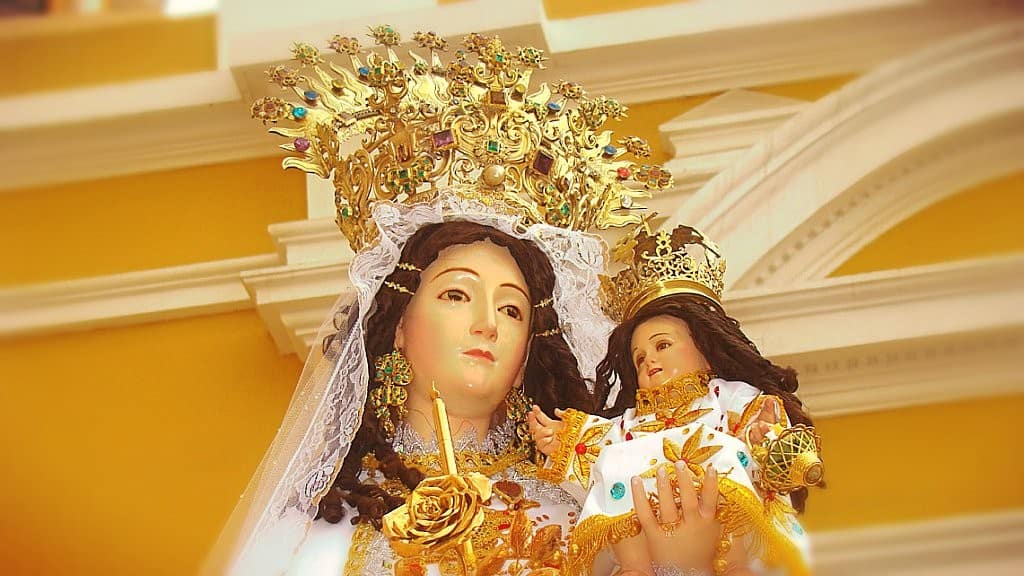February 2nd, the day of Our Lady of Candlemas, is celebrated all over the world. She is the patron saint of the Canary Islands but is also venerated in Venezuela. This is evidenced by the numerous places in the interior of the country that bear her name.
February 2, Candlemas
In the state of Merida, Venezuela, the beautiful and slender figure of Our Lady of Candelaria is venerated with great devotion and joy. Her cult has acquired worldwide importance since it combines the Christian faith with the pagan cults that originated in the Canary Islands, the cradle of its real history.
The travelers who went from there to America brought with them many of their customs, among them the devotion to the Virgin of La Candelaria, who today fills our country with honor and glory as one of its most distinguished guests.
The presence of Our Lady of Candlemas is part of our traditions and customs, as she is our spiritual mother.
Devotion in La Parroquia, Mérida
In La Parroquia, Mérida, the devotion to the Apostle of Santiago does not diminish the love and faith of its inhabitants for the Virgin of La Candelaria. The latter is venerated thanks to the oral tradition that tells the story of her apparition.
It is said that a woman while doing her housework, found a small board in her garden, took it home and the next day found it again in the same place.
The little board kept reappearing.
The lady found the picture of Our Lady of Candlemas in Zumba and decided to keep it. However, the plaque kept reappearing in the same place. To make the lady happy, the parish priest took it away.
But when the lady returned the next day, the plaque was back in the same place. After that, the priest told the lady to build a chapel in honor of the Virgin on the spot where she had appeared.
As a result, every second and third of February, the feast of Our Lady of Candlemas is celebrated in Zumba to commemorate her apparition. The devotion to the Virgin has been maintained thanks to the commitment of the servants of the Virgin, who have united to celebrate the event and keep her memory alive.
February 2nd
The 2nd of February is a very important day in Mérida because it is the beginning of the festivities of the patron saint of the city. These celebrations include a variety of activities, among which the dances of Los Vasallos de La Candelaria stand out.
These dances are an example of the artistic excellence of the people of Merida, as well as their deep religious devotion. This has made these festivities one of the most important and recognized in the country.
Worship of the Virgin of Candlemas
Here we can see the veneration of Our Lady of Candlemas, represented by the flames of the candles that symbolize the Catholic cycle of purification that began on December 24th.
This religious celebration shows the harmony between indigenous elements and Catholic cultures, such as the dances performed with maracas and colorful clothing.
The clothes worn by the dancers are reminiscent of Spanish decks: taffeta blouses, tassels and ornaments, capes with garlands, hats with wide brims and feathers and long stockings.
The dances begin very early in the morning and are performed by people from the region and foreigners who come to fulfill promises.
Promeseros of Our Lady of Candlemas
The anticipation grows when the “promeseros” arrive at the town’s chapel in search of the Virgin. This is the perfect opportunity to buy yellow tallow candles that will be blessed during the mass celebrated by the parish priest or one of the ecclesiastical authorities of Merida or the country.
These candles, known as candles of the soul, are used to help people who are in danger of dying. At the end of the mass, the Virgin is taken out in a procession by the vassals.
The captain of the cuadrilla begins to make all the petitions in her honor. Then music is played and the vassals begin to dance until noon.
The burial of the rooster
The tradition of the vassals of La Parroquia continues after many years and the day after the celebration held the dance of the “burial of the rooster”.
It is a peculiar choreography with African roots, which is not surprising given that in the area there was a trapiche where slaves of African origin were kept. The dance consists of a ritual in which a live rooster is placed in a box or basket to be sacrificed.
The eyes of the rooster are covered and one of the dancers is equipped with a whip to chase the others, who perform jumps and delirious movements. The dance ends when one of the dancers falls into a kind of trance and faints.
The devotion to Our Lady of Candlemas continues to grow among the inhabitants of the country, showing that the faith of our people will last forever, especially thanks to the miraculous presence of the Mother of Jesus in our prayers and devotions.
With information from Salomón Benshimol





